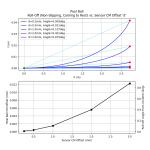By the way, moment of inertia (or a ball with heterogenous MOI) actually has no affect on the trajectory of the ball, because it produces no net torque. What it does do is modulates the rotational velocity of the ball per rotation, but extremely extremely small amounts.I had totally overlooked the (possible) moment of inertia issue with cue balls so thanks for raising it!
ChatGPT thinks suspending each ball with a thin wire to create a pendulum, and measuring the period of oscillation, is the best experimental way to evaluate the comparable moments of two equal size and mass balls.
Or for best results apparently MRI data can be used to numerically estimate moment of inertia.
A rolling ball is a precessional object like like a rolling coin or a top. Only a perfectly balanced ball has a logarithmic spiral radius of infinity, and rolls in a straight line. If you move the center of mass of the ball from center by even a fraction of a percentage (sub 0.1%) then you will start to see roll-off.
This analysis is well known in sports such as bowling (which specifically has an off-center ball for curves), lawn-bowls, golf, etc.
Here is some work I have done...
